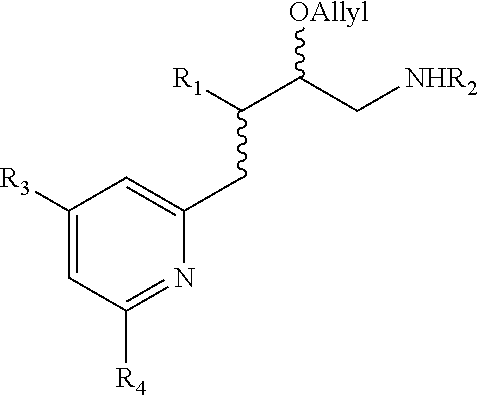Chiral Pyrrolidine Core Compounds en route to Inhibitors of Nitric Oxide Synthase
a technology of nitric oxide synthase and pyrrolidine core compounds, which is applied in the direction of organic chemistry, nervous disorder, chemistry apparatus and processes, etc., can solve the problems of difficult chromatographic purification, complicated synthesis, and high starting material costs, and achieve cost-effective effects
- Summary
- Abstract
- Description
- Claims
- Application Information
AI Technical Summary
Benefits of technology
Problems solved by technology
Method used
Image
Examples
example 1
[0030]2-(2,5-Dimethyl-1H-pyrrol-1-yl)-4,6-dimethylpyridine (8) To a solution of 4,6-dimethyl-2-aminopyridine (7, 12.2 g, 100 mmol) in toluene (100 mL) was added acetonylacetone (12.3 mL, 105 mmol) and p-TsOH (190 mg, 1.0 mmol). The reaction mixture was heated in a Dean-Stark apparatus under reflux for 6 h. After cooling to room temperature, the mixture was concentrated with a rotary evaporator, and the resulting brown oil was purified by flash column chromatography (EtOAc / hexanes, 1:19-1:9) to give 8 (18.2 g, 91 mmol, 91%) as a pale yellow solid: 1H NMR (500 MHz, CDCl3) δ 2.13 (s, 6H), 2.40 (s, 3H), 2.56 (s, 3H), 5.88 (s, 2H), 6.85 (s, 1H), 7.00 (s, 1H); 13C NMR (125 MHz, CDCl3) δ 13.4, 21.2, 24.4, 106.8, 119.9, 123.1, 128.6, 149.6, 151.7, 158.4; LCQ-MS (M+H+) calcd for C13H17N2 201, found 201; LC-TOF-MS (M+H+) calcd for C13H17N2 201.13917, found 201.13881.
example 2
[0031]2-(2,5-Dimethyl-1H-pyrrol-1-yl)-4-methyl-6-((trimethylsilyl)methyl)pyridine (9). To a solution of 8 (6.0 g, 30 mmol) in THF (100 mL) at 0° C. was added n-BuLi (1.6 M in hexanes, 21 mL, 33 mmol). The solution turned dark red during the addition. After stirring at the same temperature for an additional 2 h, chlorotrimethylsilane (4.2 mL, 33 mmol) was added dropwise to the reaction mixture. The reaction was warmed to room temperature and allowed to stir for an additional 1 h. The resulting bright yellow slurry was partitioned between EtOAc (200 mL) and H2O (100 mL). The organic layer was washed with brine (100 mL), dried over NaSO4, and concentrated. The crude product was purified by flash column chromatography (EtOAc / hexanes, 1:19-1:9) to give 9 (7.7 g, 28.5 mmol, 95%) as a pale yellow oil: 1H NMR (500 MHz, CDCl3) δ 0.10 (s, 9H), 2.13 (s, 6H), 2.39 (s, 3H), 2.41 (s, 3H), 5.89 (s, 2H), 6.78 (s, 1H), 6.85 (s, 1H); 13C NMR (125 MHz, CDCl3) δ−1.5, 13.1, 20.9, 29.8, 106.2, 118.7, 121...
example 3
[0032]2-(Bromomethyl)-6-(2,5-dimethyl-1H-pyrrol-1-yl)-4-methylpyridine (6). To a solution of 9 (5.6 g, 21 mmol) in DMF (100 mL) was added 1,2-dibromotetrafluoroethane (10 g, 42 mmol) and CsF (6.4 g, 42 mmol). The reaction was allowed to stir at room temperature for 3 h, and the resulting purple solution was concentrated and loaded directly on flash column chromatography (EtOAc / hexanes, 1:19-1:9) to give 6 (5.7 g, 20.8 mmol, 99%) as a pale yellow oil: 1H NMR (500 MHz, CDCl3) δ 2.19 (s, 6H), 2.47 (s, 3H), 4.56 (s, 2H), 5.93 (s, 2H), 7.01 (s, 1H), 7.30 (s, 1H); 13C NMR (125 MHz, CDCl3) δ 13.3, 21.1, 33.5, 107.1, 121.8, 122.9, 128.5, 150.7, 151.7, 156.3; LCQ-MS (M+H+) calcd for CI3H16BrN2 279, found 279; LC-TOF-MS (M+H+) calcd for C13H16BrN2 279.04969, found 279.04963.
PUM
 Login to View More
Login to View More Abstract
Description
Claims
Application Information
 Login to View More
Login to View More - R&D
- Intellectual Property
- Life Sciences
- Materials
- Tech Scout
- Unparalleled Data Quality
- Higher Quality Content
- 60% Fewer Hallucinations
Browse by: Latest US Patents, China's latest patents, Technical Efficacy Thesaurus, Application Domain, Technology Topic, Popular Technical Reports.
© 2025 PatSnap. All rights reserved.Legal|Privacy policy|Modern Slavery Act Transparency Statement|Sitemap|About US| Contact US: help@patsnap.com



